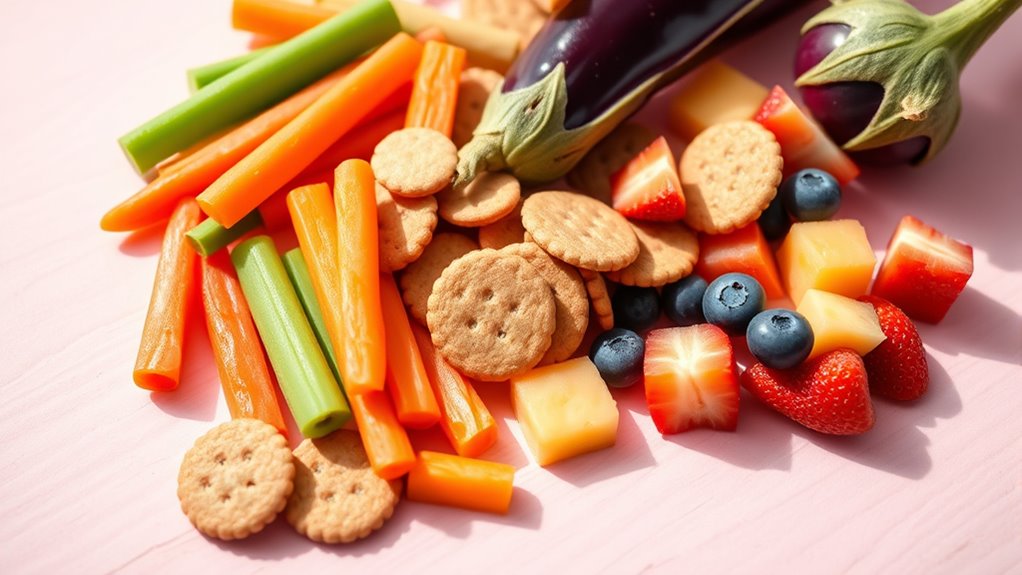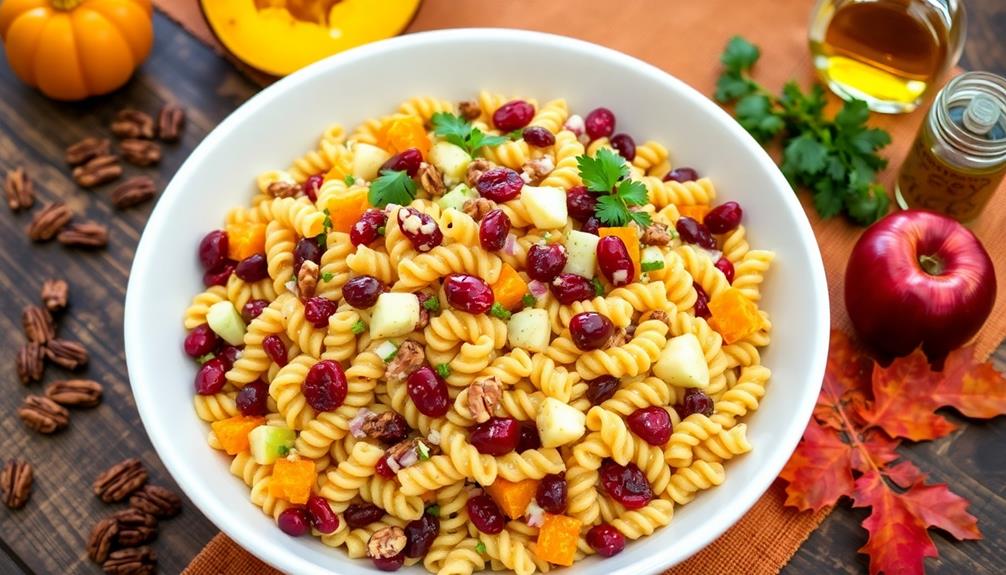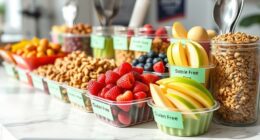To create smart snacks for toddlers, focus on balanced nutrients like proteins, whole grains, healthy fats, and essential vitamins and minerals. Incorporate colorful fruits and vegetables, fun dips, and small, manageable portions to encourage healthy habits. Hydration is also key—serve flavored water or water-rich fruits to keep little ones refreshed. By choosing nutrient-dense options and preparing ahead, you’ll support their growth and development—keep exploring to discover more tips for nutritious, engaging snacks.
Key Takeaways
- Offer balanced snacks with carbohydrates, healthy fats, and vitamins to support toddler growth and sustained energy.
- Incorporate protein-rich foods like yogurt, cheese, eggs, and beans to promote muscle and brain development.
- Include whole grains such as oats, brown rice, and quinoa for lasting energy and digestive health.
- Use colorful fruits and vegetables with dips to boost vitamin intake and make snacks visually appealing.
- Prepare portion-controlled, nutrient-dense snack packs for routine, safe, and engaging eating experiences.
The Importance of Balanced Nutrients for Toddlers
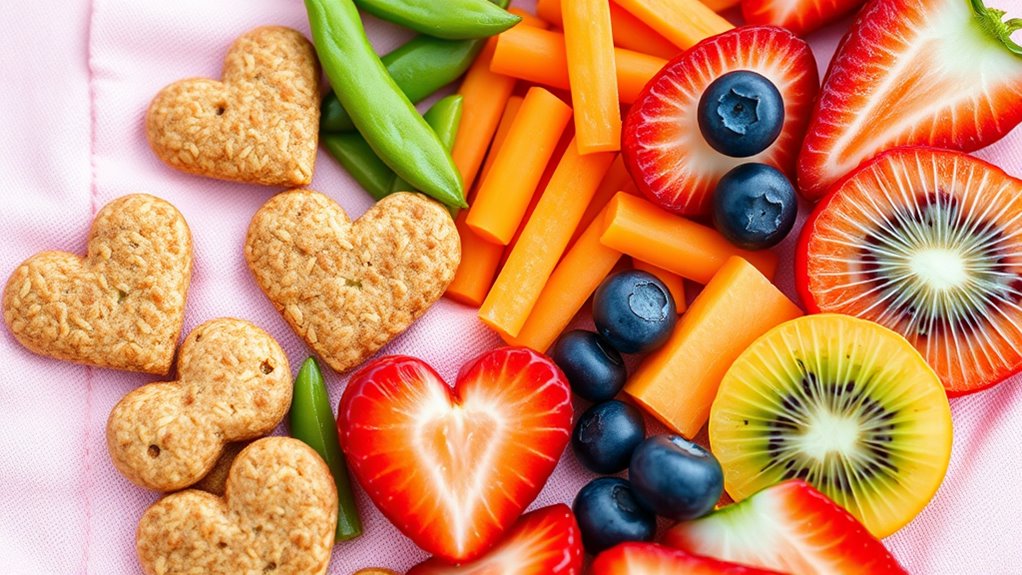
Since toddlers are growing rapidly, providing them with balanced nutrients is essential for their development. Proper snack packaging plays a key role in ensuring you offer the right amount of food without overwhelming them. Portion control helps manage their intake, preventing overeating while still meeting their nutritional needs. By choosing snacks that contain a mix of carbohydrates, healthy fats, and vitamins, you support their energy levels and growth. Keeping in mind the home maintenance of a balanced diet ensures that their nutritional needs are consistently met. Keep in mind that small, manageable portions are best—this encourages healthy eating habits early on. Always check snack packaging for ingredient information to avoid excess sugars or artificial additives. When you control portions and select nutrient-rich snacks, you give your toddler the foundation for healthy growth and development. Incorporating nutritional balance can further promote their overall health and happiness.
Protein-Powered Snacks for Growth and Development
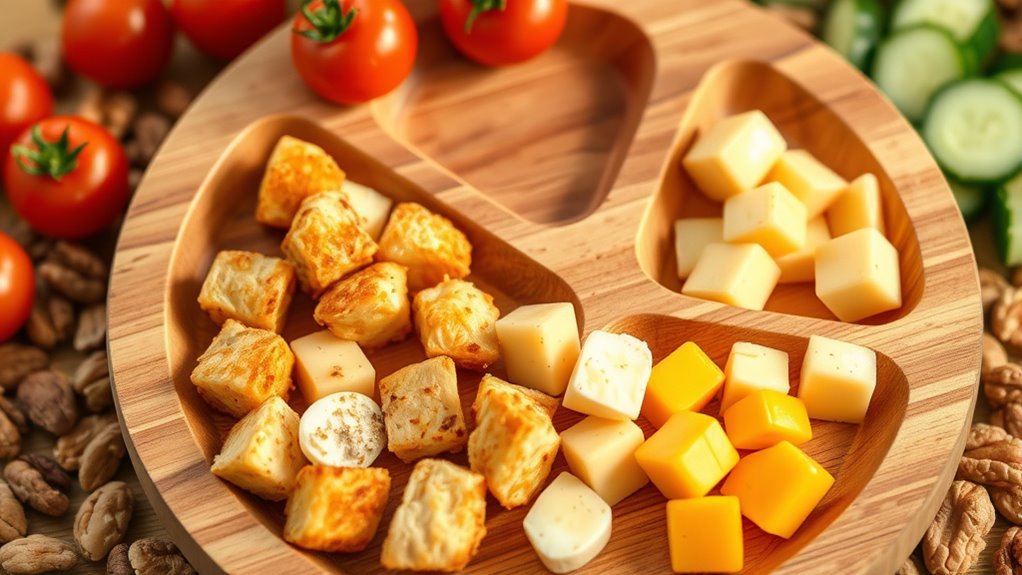
Protein is a crucial nutrient that supports your toddler’s muscle growth, brain development, and overall strength. Providing protein snacks helps guarantee your little one gets enough of this essential nutrient for healthy toddler growth. Easy options include yogurt, cheese, hard-boiled eggs, or nut butters, which are convenient and appealing for young children. Incorporate small portions of lean meats or beans into snacks to boost their protein content naturally. These snacks not only promote muscle development but also keep your toddler energized throughout the day. Remember, offering a variety of protein sources encourages balanced growth and helps establish healthy eating habits early on. Giving your child nutritional building blocks through these snacks sets a foundation for lifelong health and well-being. By choosing protein-powered snacks, you’re giving your child the building blocks for strong bones, sharp minds, and healthy development.
Whole Grains: Fueling Tiny Bodies With Energy

Whole grains are an excellent source of sustained energy for your toddler, helping them stay active and alert throughout the day. Incorporate different grain varieties like oats, brown rice, quinoa, and whole wheat into snacks. Proper cooking techniques, such as soaking oats or rinsing quinoa, enhance digestibility and flavor. Experiment with textures by baking or steaming to make grains more appealing. Combining grains with fruits or vegetables boosts nutrients and flavors. Using a variety of grains ensures your toddler gets diverse benefits, like fiber and essential nutrients. Additionally, understanding the importance of whole grain consumption can help you make healthier choices for your child’s diet. Growing chia seeds at home can be a fun and educational activity that introduces your little one to sustainable food sources and the benefits of organic farming. Incorporating nutrient-dense grains into your child’s meals supports their growth and development. Here’s a quick guide:
| Grain Variety | Cooking Tip |
|---|---|
| Oats | Use quick oats for easier prep |
| Brown Rice | Cook with extra water for fluff |
| Quinoa | Rinse well before cooking |
| Whole Wheat | Substitute in familiar recipes |
Healthy Fats Supporting Brain and Eye Development

Healthy fats are essential for your toddler’s brain and eye development, providing the building blocks for ideal growth. Omega-3 fats, especially DHA, are critical components that support neural connections and cognitive skills. Including sources like fatty fish, chia seeds, and flaxseed in snacks helps guarantee your child receives these vital nutrients. Omega-3 fatty acids are crucial for maintaining optimal brain and eye health, especially during rapid growth phases. These healthy fats also play a significant role in eye development, sharpening vision and maintaining eye health as your toddler grows. Incorporating small servings of omega-3-rich foods into their diet can boost brain function and improve focus. Proper nutrition supports overall development and is vital during this critical growth phase. Regularly offering a variety of healthy fats can also help support fats’ role in cellular development and overall growth processes.
Vitamins and Minerals Essential for Immune Strength

Vitamins and minerals play an essential role in boosting your toddler’s immune system, helping them fight off illnesses and stay healthy. Key nutrients like vitamin C, vitamin D, zinc, and iron support immune support by strengthening their body’s defenses. A vitamin deficiency in these areas can leave your child more vulnerable to infections. Including foods rich in these nutrients, such as citrus fruits, dairy, lean meats, and leafy greens, guarantees your toddler gets essential building blocks for immunity. Regularly offering a variety of colorful, nutrient-dense snacks helps prevent deficiencies and promotes overall health. Additionally, understanding pinball machine weight is important if you’re considering home installation or maintenance. Recognizing the importance of proper nutritional balance can enhance your child’s overall growth and resilience. Maintaining a well-rounded diet also supports heat pump efficiency, ensuring your child benefits from a consistently healthy environment. Remember, a balanced intake of vitamins and minerals is indispensable for maintaining a robust immune system and supporting your child’s growth and resilience.
Hydration and Snack Choices: Keeping Toddlers Refreshed
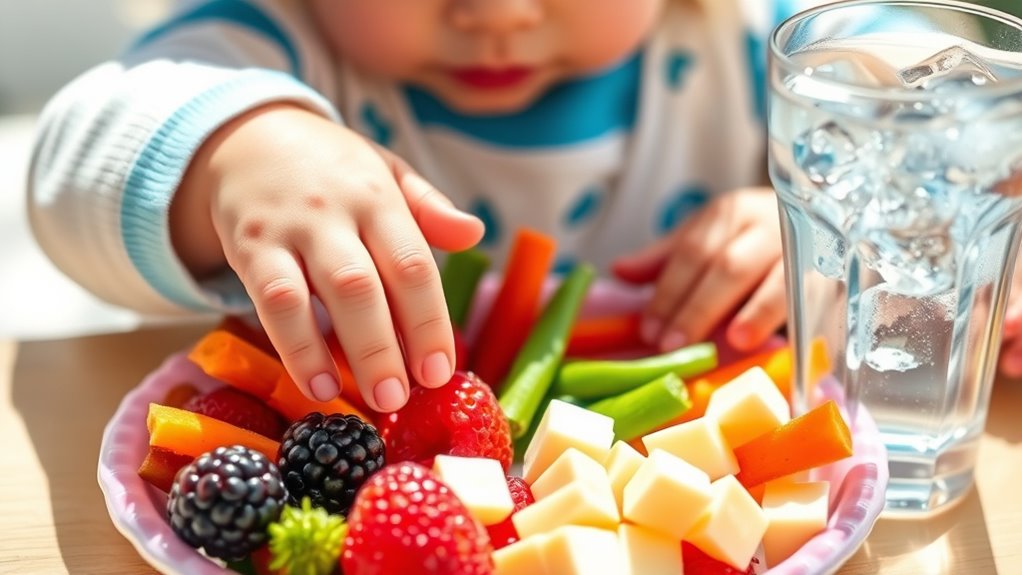
Keeping your toddler well-hydrated is key to their energy and health. Choosing the right fluids, like water or milk, guarantees they stay refreshed without added sugar. Pairing healthy snack options with these drinks helps maintain their hydration throughout the day. Incorporating aesthetic mug and glass styles can make hydration more appealing for toddlers.
Optimal Fluids for Toddlers
Ensuring your toddler stays well-hydrated is essential for their growth and development. Many hydration myths suggest that toddlers need large amounts of water, but fluid intake guidelines recommend about 4 cups daily, including water, milk, and other fluids. It’s common to underestimate how much your child needs, but overhydration can also be a concern. The key is offering fluids regularly and in appropriate amounts, especially during active play or hot weather. Avoid sugary drinks like sodas or fruit juices, as they can lead to cavities and unnecessary calorie intake. Instead, focus on water and milk as primary options. Staying mindful of these guidelines helps keep your toddler refreshed, supports their health, and ensures they’re getting the right balance of hydration without overdoing it.
Healthy Snack Hydration Options
Choosing snacks that help keep your toddler hydrated can make a big difference in their overall health and energy levels. To boost hydration, consider incorporating water infusions or flavored waters into snack time. These options are appealing and can encourage your toddler to drink more fluids. Here are some ideas:
- Add slices of fruit like strawberries or oranges to water infusions for natural sweetness.
- Mix herbs such as mint or basil into water for an invigorating twist.
- Serve small cups of flavored waters that contain minimal added sugars.
- Offer crunchy fruits like watermelon or cucumber, which have high water content and help with hydration.
- Using smart technology in water bottles can help monitor your child’s hydration levels and remind them to drink regularly.
These choices make snack time both delicious and hydrating, supporting your toddler’s growth and energy.
Creative and Nutritious Snack Ideas for Little Hands
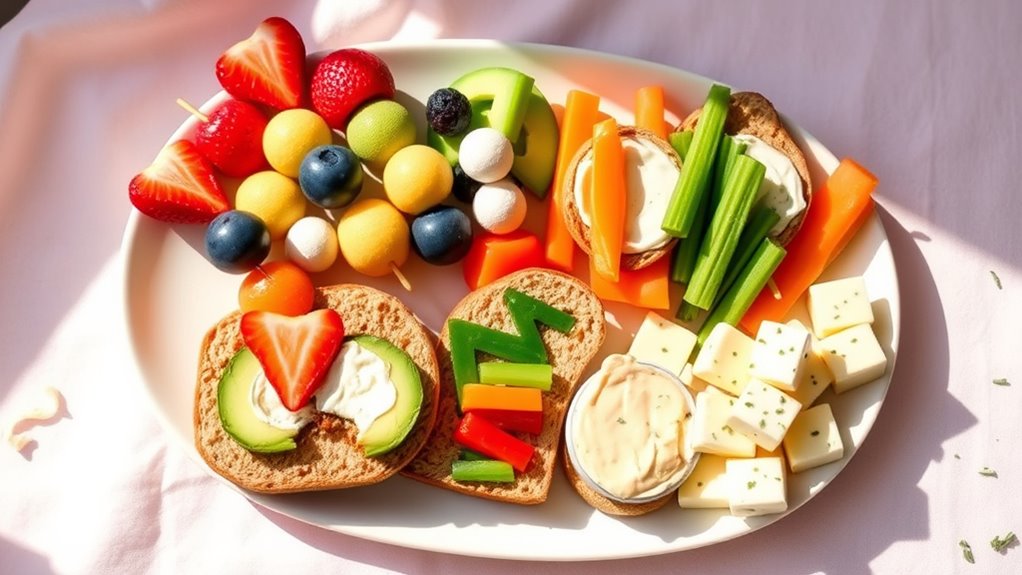
You can make snack time fun and nutritious by using healthy dips and spreads that encourage little ones to explore new flavors. Bright, colorful fruit and veggie bites not only catch their eye but also boost their intake of essential nutrients. These creative ideas turn snack time into an enjoyable and nourishing experience for your toddler. Incorporating a sprinkle of fiber-rich foods like chia seeds into snacks can further promote healthy digestion and satiety. Additionally, understanding the importance of ethical hacking can help caregivers ensure the digital safety of their family online.
Healthy Dips and Spreads
Healthy dips and spreads turn simple snacks into fun, nutritious bites your toddler will love to dip and spread with their little hands. They encourage independent eating and can boost nutrient intake. Consider these options:
- Dairy dips like Greek yogurt mixed with a touch of honey or herbs offer calcium and probiotics. They can also be flavored with natural ingredients to enhance taste without added sugars.
- Nut spreads such as almond or cashew butter provide healthy fats and protein.
- Hummus made from chickpeas and tahini adds fiber and plant-based protein.
- Avocado mash delivers healthy monounsaturated fats and essential nutrients.
- Using safe, durable, and non-toxic containers can help prevent spills and ensure safety during snack time. Incorporating topical authority in recipes ensures the dips meet nutritional standards and appeal to little taste buds.
These dips are easy to prepare and serve alongside cut vegetables, toast, or crackers, making snack time both tasty and nourishing. Keep portions small to prevent messes and help your toddler enjoy these nutritious options confidently.
Colorful Fruit and Veggie Bites
Brightly colored fruit and veggie bites turn simple snacks into fun, eye-catching treats that little hands can easily grasp. You can create vibrant fruit skewers by threading chunks of strawberries, grapes, and melons onto small, safe skewers or toothpicks. These are perfect for encouraging kids to try new flavors and textures. Veggie wraps are another great option; fill small whole wheat tortillas with thin slices of cucumber, bell peppers, and carrots, then roll them up into easy-to-hold bites. Cutting wraps into small pieces makes them perfect for toddlers to enjoy independently. Both fruit skewers and veggie wraps offer a colorful, nutritious way to introduce a variety of vitamins and minerals, making snack time both fun and beneficial for your little one’s growth and development.
Tips for Incorporating Nutrient-Rich Snacks Into Daily Routines

Incorporating nutrient-rich snacks into your toddler’s daily routine can be simple and enjoyable when you plan ahead. Start with meal prep to create a variety of healthy options in advance, saving time during busy days. Practice portion control by offering small servings that match your child’s hunger cues, reducing waste and overeating. Here are some tips:
- Prepare snack packs in advance, using small containers for easy grab-and-go.
- Incorporate a mix of fruits, veggies, and protein sources to keep snacks balanced.
- Establish routine snack times to create consistency and predictability.
- Involve your toddler in choosing and preparing snacks to make them more engaged and willing to try new foods. These strategies help ensure your toddler receives the nutrients they need while making snack time manageable for you.
Frequently Asked Questions
How Can I Introduce New Snacks Without Causing Food Aversions?
To introduce new snacks without causing food aversions, start by offering small amounts alongside familiar foods. Encourage sensory exploration by letting your toddler touch, smell, and taste gradually. Be patient and avoid pressuring them, especially if they’re picky eaters. Keep mealtimes positive and consistent, and offer new snacks multiple times without forcing. This approach builds trust and helps your toddler develop a healthy, adventurous attitude toward new foods.
Are Organic Snacks Significantly Better for Toddlers Than Non-Organic Options?
You might think organic snacks are a miracle for your toddler, but they’re not always dramatically better than non-organic options. Organic benefits include fewer pesticides and more natural farming, but non-organic concerns are often overstated. Both can be nutritious if chosen wisely. Focus on ingredient quality and variety rather than solely on organic labels, and you’ll give your toddler a balanced, healthy snack lineup that doesn’t rely on the organic hype.
How Do I Manage Allergies When Offering Diverse Snack Options?
To manage allergies when offering diverse snack options, always check labels for allergy-friendly options and avoid common allergens. You should prioritize safe snack substitutions like fruit slices, veggie sticks, or allergy-friendly crackers. Keeping an allergy action plan handy and consulting with your child’s healthcare provider guarantees you’re prepared for reactions. By staying vigilant and choosing safe, allergy-friendly options, you create a variety of nutritious snacks that keep your toddler safe.
What Portion Sizes Are Appropriate for Different Toddler Ages?
For toddlers, sticking to age-appropriate servings is key. For ages 1-2, offer about 1/4 to 1/2 cup of snacks per serving, while 2-3-year-olds can handle around 1/2 to 1 cup. Follow portion guidelines based on your child’s age and appetite, paying attention to hunger cues. Always aim for balanced snacks that support their growth and development, avoiding overfeeding or underfeeding.
How Can I Make Snack Time More Engaging and Educational?
Imagine turning snack time into a chess game—strategic, fun, and engaging. You can make it educational by using creative presentation, like colorful plates or themed shapes. Incorporate sensory activities, such as textured fruits or fragrant herbs, to stimulate their senses. Ask simple questions about colors, shapes, or tastes, making learning interactive. This approach keeps your toddler interested, encourages exploration, and makes snack time both fun and educational.
Conclusion
Think of your toddler’s nutrition as planting a tiny garden. With each balanced snack, you’re watering seeds of growth, sunshine fueling their brain, and nourishing roots building resilience. As you choose wholesome, vibrant foods, you cultivate a strong, thriving little garden—full of energy, curiosity, and health. Keep tending this garden daily, and watch your little one blossom into their brightest, happiest self. Every healthy nibble helps grow their future.
